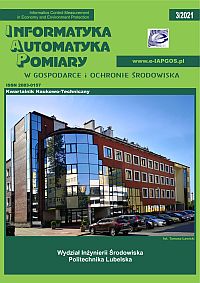INFLUENCE OF A PLATFORM GAME CONTROL METHOD ON A PLAYER’S EFFECTIVENESS
Article Sidebar
Open full text
Issue Vol. 11 No. 3 (2021)
-
USING STEALTH TECHNOLOGIES IN MOBILE ROBOTIC COMPLEXES AND METHODS OF DETECTION OF LOW-SIGHTED OBJECTS
Andrii Rudyk, Andriy Semenov, Olena Semenova, Sergey Kakovkin4-8
-
SMART POWER WHEELCHAIR: PROBLEMS AND CHALLENGES OF PRODUCT APPROACH
Serge Ageyev, Andrii Yarovyi9-13
-
IMPROVING THE ACCURACY OF VIBRATION MEASUREMENT RESULTS
Anzhelika Stakhova, Volodymyr Kvasnikov14-17
-
CUSTOMIZATION BASED ON CAD AUTOMATION IN PRODUCTION OF MEDICAL SCREWS BY 3D PRINTING
Piotr Bednarczuk18-21
-
METHOD AND GAS DISCHARGE VISUALIZATION TOOL FOR ANALYZING LIQUID-PHASE BIOLOGICAL OBJECTS
Yaroslav A. Kulyk, Bohdan P. Knysh, Roman V. Maslii, Roman N. Kvyetnyy, Valentyna V. Shcherba, Anatoliy Ia. Kulyk22-29
-
OVERVIEW OF SKIN DIAGNOSTIC TECHNIQUES BASED ON MULTILAYER SKIN MODELS AND SPECTROPHOTOMETRICS
Magdalena Michalska30-33
-
DYNAMIC HANDWRITTEN SIGNATURE IDENTIFICATION USING SPIKING NEURAL NETWORK
Vladislav Kutsman, Oleh Kolesnytskyj34-39
-
GRANULAR REPRESENTATION OF THE INFORMATION POTENTIAL OF VARIABLES - APPLICATION EXAMPLE
Adam Kiersztyn, Agnieszka Gandzel, Maciej Celiński, Leopold Koczan40-44
-
INFLUENCE OF A PLATFORM GAME CONTROL METHOD ON A PLAYER’S EFFECTIVENESS
Bartosz Wijatkowski, Jakub Smołka, Maciej Celiński45-49
-
A REVIEW OF CURRENTLY USED ISOLATED DC-DC CONVERTERS
Damian Dobrzański50-54
Archives
-
Vol. 13 No. 4
2023-12-20 24
-
Vol. 13 No. 3
2023-09-30 25
-
Vol. 13 No. 2
2023-06-30 14
-
Vol. 13 No. 1
2023-03-31 12
-
Vol. 12 No. 4
2022-12-30 16
-
Vol. 12 No. 3
2022-09-30 15
-
Vol. 12 No. 2
2022-06-30 16
-
Vol. 12 No. 1
2022-03-31 9
-
Vol. 11 No. 4
2021-12-20 15
-
Vol. 11 No. 3
2021-09-30 10
-
Vol. 11 No. 2
2021-06-30 11
-
Vol. 11 No. 1
2021-03-31 14
-
Vol. 10 No. 4
2020-12-20 16
-
Vol. 10 No. 3
2020-09-30 22
-
Vol. 10 No. 2
2020-06-30 16
-
Vol. 10 No. 1
2020-03-30 19
-
Vol. 9 No. 4
2019-12-16 20
-
Vol. 9 No. 3
2019-09-26 20
-
Vol. 9 No. 2
2019-06-21 16
-
Vol. 9 No. 1
2019-03-03 13
Main Article Content
DOI
Authors
Abstract
The aim of this research is to check which of two devices the keyboard or the controller – has a positive effect on a player's game-play in a platform game. Four parameters are defined: death count, error count, game time, learning time. A custom game is designed and implemented specifically for the research. The conducted experiment is divided into thirty-minute sessions, during which one player participates in the game after getting acquainted with the game’s mechanics. After completing the game, he/she fills out a survey in which he/she can express his/her level of satisfaction while using the assigned device. Each player has only one attempt. 16 players agree to participate. They are divided into two groups of 8 people each. Participants in the first group use the keyboard while those in the second group use the controller. In order to determine final results for the tested devices, the AHP method is used. The importance values for all pairs of measured parameters are determined in order to calculate their priorities. The priorities allow for distinguishing important from less important parameters. For this purpose, a survey of experienced players is conducted. They help to identify parameter importance. After trials and analysis of responses from the game-play satisfaction and parameter importance surveys, it turns out that players using the keyboard achieve better results, and the keyboard is more satisfying to use.
Keywords:
References
Arsenault D.: Video game genre, evolution and innovation. Eludamos, Journal for computer game culture 3(2), 2009, 149–176.
Borowsky A., Oron-Gilad T., Parmet Y.: Age and skill differences in classifying hazardous traffic scenes. Transportation Research Part F: Traffic Psychology and Behaviour 12(4), 2009, 277–287. DOI: https://doi.org/10.1016/j.trf.2009.02.001
Camilleri E., Yannakakis G. N., Dingli A.: Platformer level design for player believability. IEEE Conference on Computational Intelligence and Games (CIG), 2016, 1–8. DOI: https://doi.org/10.1109/CIG.2016.7860404
Hufnal D., Osborne E., Johnson T., Yildirim C.: The impact of controller type on video game user experience in virtual reality. IEEE Games, Entertainment, Media Conference (GEM), 2019, 1–9. DOI: https://doi.org/10.1109/GEM.2019.8811543
Linnet J., Gebauer L., Shaffer H., Mouridsen K., Møller A.: Experienced poker players differ from inexperienced poker players in estimation bias and decision bias. Journal of Gambling Issues 24, 2010, 86–100. DOI: https://doi.org/10.4309/jgi.2010.24.6
Lukosek G.: Learning C# by Developing Games with Unity 5.x – Second Edition. Packt Publishing 2016.
Mikami K., Kondo K.: Adaptable Game Experience Based on Player's Performance and EEG. Niograph International (NicoInt), 2017, 1–8.
Rouse R.: Game design: Theory and practice. Jones & Bartlett Learning 2004.
Saaty T. L.: What is the analytic hierarchy process? Mathematical models for decision support. Springer, 1988. DOI: https://doi.org/10.13033/isahp.y1988.042
Schrepp M.: User experience questionnaire handbook: All you need to know to apply the UEQ successfully in your project. 2015 [http://doi.org/10.13140/RG.2.1.2815.0245].
Smith G., Cha M., Whitehead J.: A framework for analysis of 2D platformer levels. Proceedings of the 2008 ACM SIGGRAPH symposium on Video games, 75–80. DOI: https://doi.org/10.1145/1401843.1401858
Smith J. D., Graham T. N.: Use of eye movements for video game control. Proceedings of the ACM SIGCHI international conference on Advances in computer entertainment technology 2006. DOI: https://doi.org/10.1145/1178823.1178847
Spool J. M.: What makes a design seem 'intuitive'. User Interface Engineering 10(01), 2005.
Torres-Ferreyros C. M., Festini-Wendorff M. A., Shiguihara-Juárez P.: Developing a videogame using unreal engine based on a four stages methodology. IEEE ANDESCON, 2016, 1–4. DOI: https://doi.org/10.1109/ANDESCON.2016.7836249
Quek A., See J.: The invoker: Intuitive gesture mechanics for motion-based shooter RPG. Game Physics and Mechanics International Conference (GAMEPEC), 2015, 6–10. DOI: https://doi.org/10.1109/GAMEPEC.2015.7331847
Article Details
Abstract views: 396
License

This work is licensed under a Creative Commons Attribution-ShareAlike 4.0 International License.






